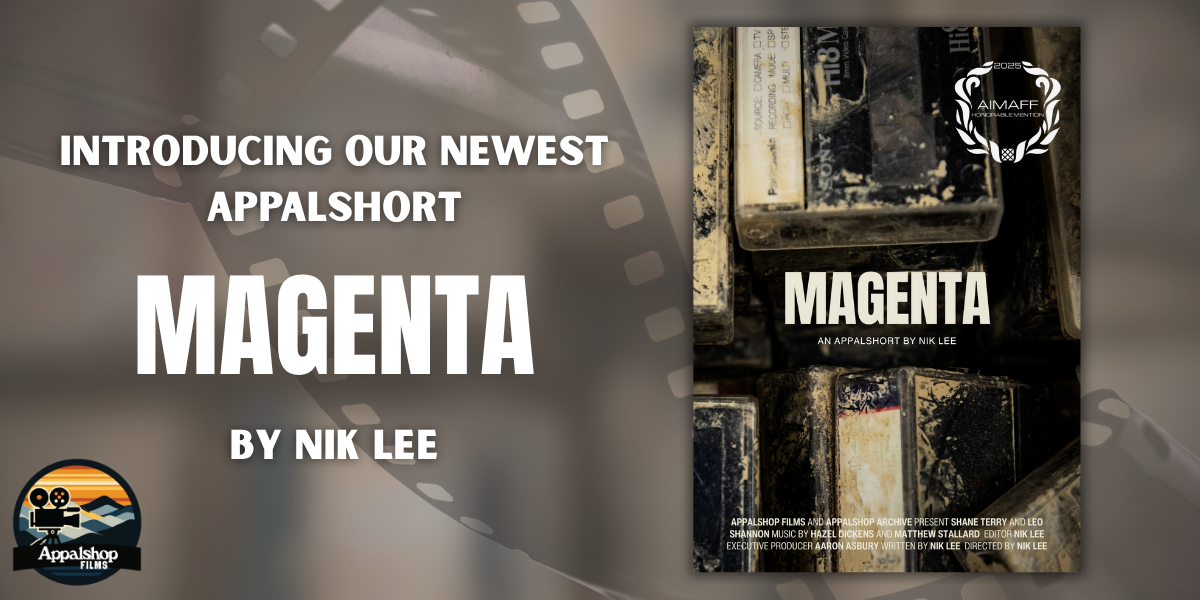By Mike Templeton
People in Eastern Kentucky and other parts of the Appalachian region are still digging out, rebuilding, and trying to make sense after the devastating floods of 2022 which will leave its impact on the region forever. Indeed, the very geography of Eastern Kentucky was altered by these floods. The flood touched the lives of people within the Urban Appalachian Community Coalition who call that region home and still have family and friends in the impacted areas. Testaments from the flooding have come in the form of the book Troublesome Rising: A Thousand Year Flood in Eastern Kentucky produced by Hindman Settlement School, which we have covered in this blog. Among those impacted by the floods were the people and sites of another hard-hit Appalachian nonprofit, Appalshop, the arts and media organization in Whitesburg, Kentucky, including their archives. “Magenta,” a new short documentary film by Nik Lee and Shane Terry, documents the efforts of Appalshop Archive staff as they work painstakingly but successfully to restore materials that were damaged by these floods.
The five-day period of relentless rain and flooding that occurred in Eastern Kentucky in 2022 left 45 people dead, countless homeless, and wiped out entire communities. The flooding devastated Eastern Kentucky, parts of West Virginia, and Virginia, and was so singular it earned the name “the thousand-year flood” as something that could only happen once in a thousand years. Filmmaker Nik Lee, also the Internal Media Coordinator for Appalshop, was inspired to make the film for two reasons. One was concern over funding for Appalshop and the archive, and the other was to document the massive effort required to rescue materials that are integral parts of Appalachian history from the ravages of the floods.
“Magenta” is obviously a film unto itself, but the story it tells is one of films and stories. It is a film about the preservation of Appalachian history within a grand effort to preserve Appalachian history on into infinity. We see again and again how Shane Terry, Archive Operations Technician, and Nik Lee are working with nearly destroyed pieces of film and video tape, restoring it, at times entirely, so that we are watching images of images and images of the artifacts of images. It is a truly astounding sight watch how these people work with the bits and pieces that were rescued from the floods (including footage of the floods), while the center of gravity in the film seems to recede away from us. The title, “Magenta,” is taken from the color of faded and lost film. When the images on film fade to an indistinct mix of color, the film takes on the color of magenta. Yet, even as the film’s approach becomes dizzying, it is countered with the intense clarity of Shane Terry and others lifting boxes of rescued materials from a storage site. Working in what is clearly sweltering heat, the work of restoration begins with literal heavy lifting. But we also get a clear look at the work of Shane Terry and Nik Lee as they meticulously work with pieces and strands of film and tape that are in fact the pieces and strands of Appalachian history. Terry explains in the opening moments of “Magenta” that the materials they are working with “go back to 1969, if not before,” while the films themselves contain historical documentation which spans the better part of a century.
Given the nature of the flooding, it is hard to imagine anything as delicate as old film and video tape coming through intact. It is the dedication of the folks at Appalshop that we have to thank for saving it all. There is a moving juxtaposition of worlds and ages as we watch them painstakingly re-assemble fragments of old film and video tape. We know some of the restoration work is distinctly high-tech, but we get a powerful moment in the film as we witness a hand turning an old metal film winder re-spooling a span of film. The ages and worlds collide throughout “Magenta,” and that is precisely the point. The Appalshop archives are some of the most important resources and documents of Appalachian history. We have access to that history because of our very modern capabilities. We can come in contact with that history because of the skills of dedicated people like the Appalshop Archive workers. The whole of this kind of mix of ages and worlds seems to collapse in a moment toward the end of the film when we realize we are watching a film of an archive worker taking a photo of an old video tape with a digital phone. What is past, what we count as historical, always exists in the present, and it is our present task to preserve the past.
In all, “Magenta” is a powerful work; a short documentary that is one of those rare works that is the very thing it documents: a story of the preservation of Appalachian history that is itself a work of preservation of Appalachian history. This is the kind of work that finds a place with the Urban Appalachian Community Coalition as a piece of our own research and advocacy efforts. Appalshop never disappoints with the work they do. They are instrumental not only in providing priceless materials for the study of Appalachian culture and history, but they are also a place where a new group of people are constantly coming into their own as filmmakers, photographers, and writers of the past, present, and future of Appalachians and our homeplaces. You can watch “Magenta” on the Appalshop YouTube at this link: www.youtube.com/watch?v=aKQ83v9YabU.
More information on Appalshop can be found at this link: appalshop.org.
Michael Templeton is a writer, and independent scholar. He is the author of The Chief of Birds: A Memoir published with Erratum Press and Impossible to Believe, published by Iff Books. He is also the author of Collected Apoems, forthcoming from LJMcD Communications and the awaiting of awaiting: a novella, with Nut Hole Publishing. Check out his profile in UACC’s Cultural Directory. He has published numerous articles and essays on contemporary culture and works of creative non-fiction as well as experimental works and poetry. He lives in West Milton, Ohio with his wife who is an artist.

